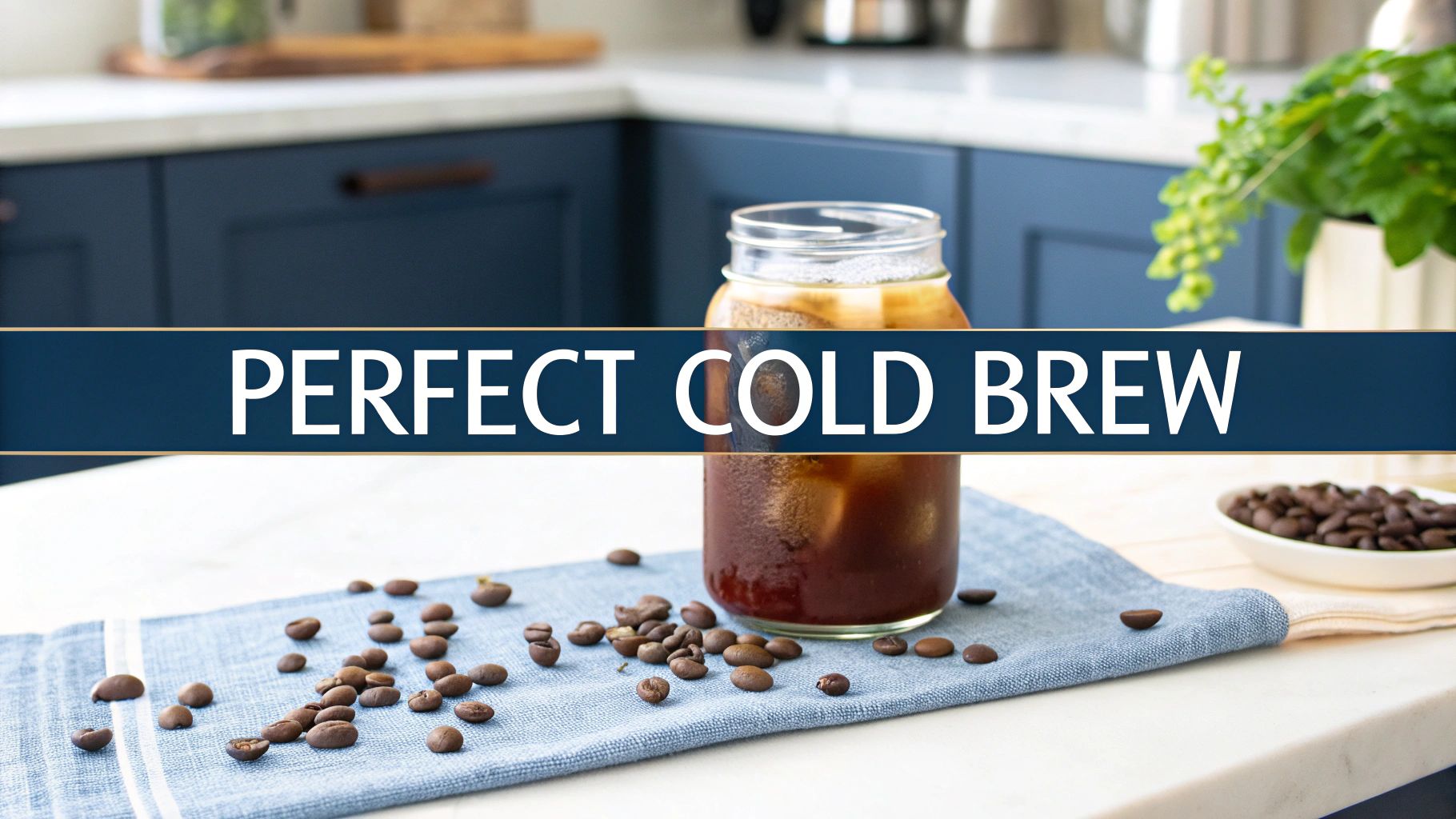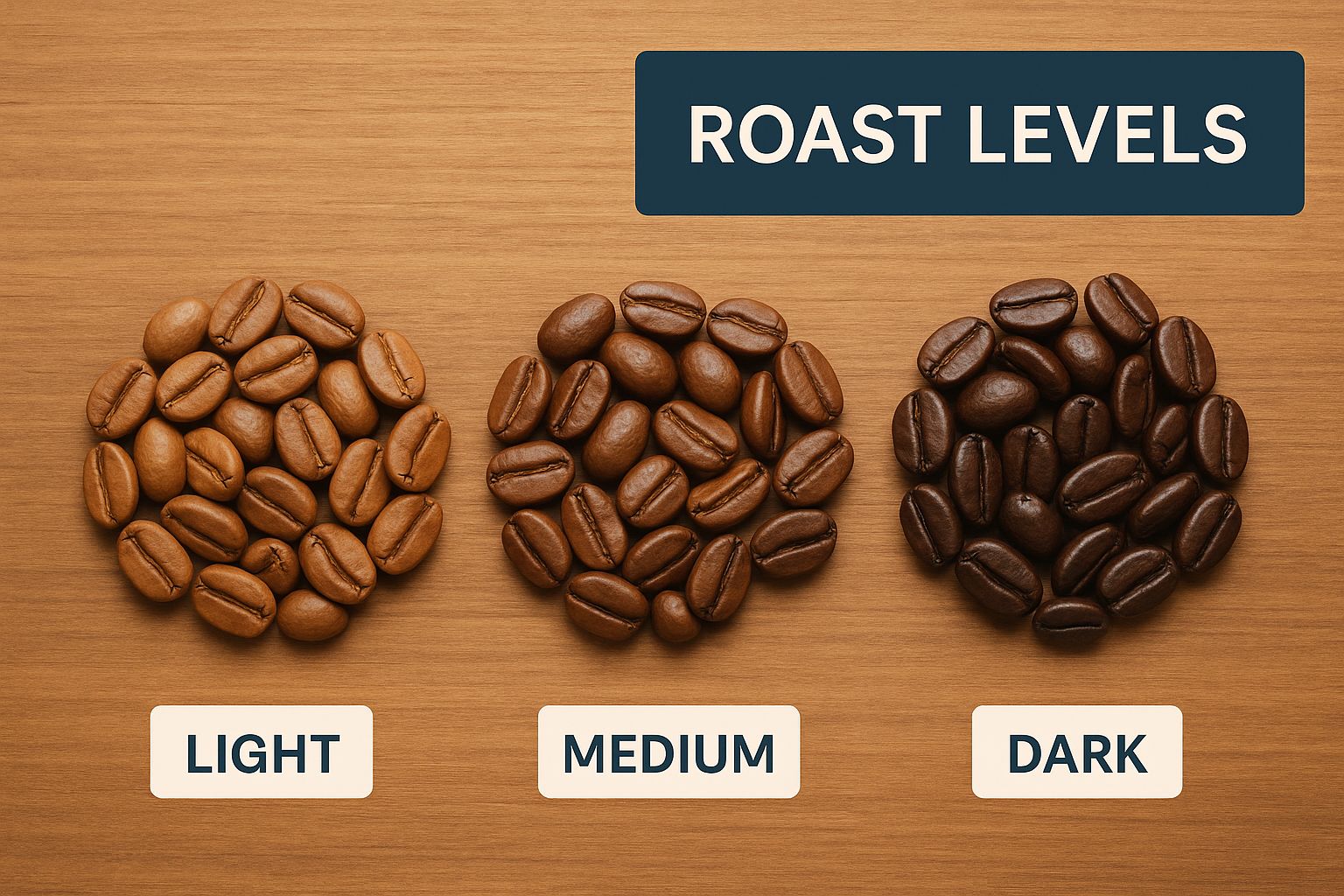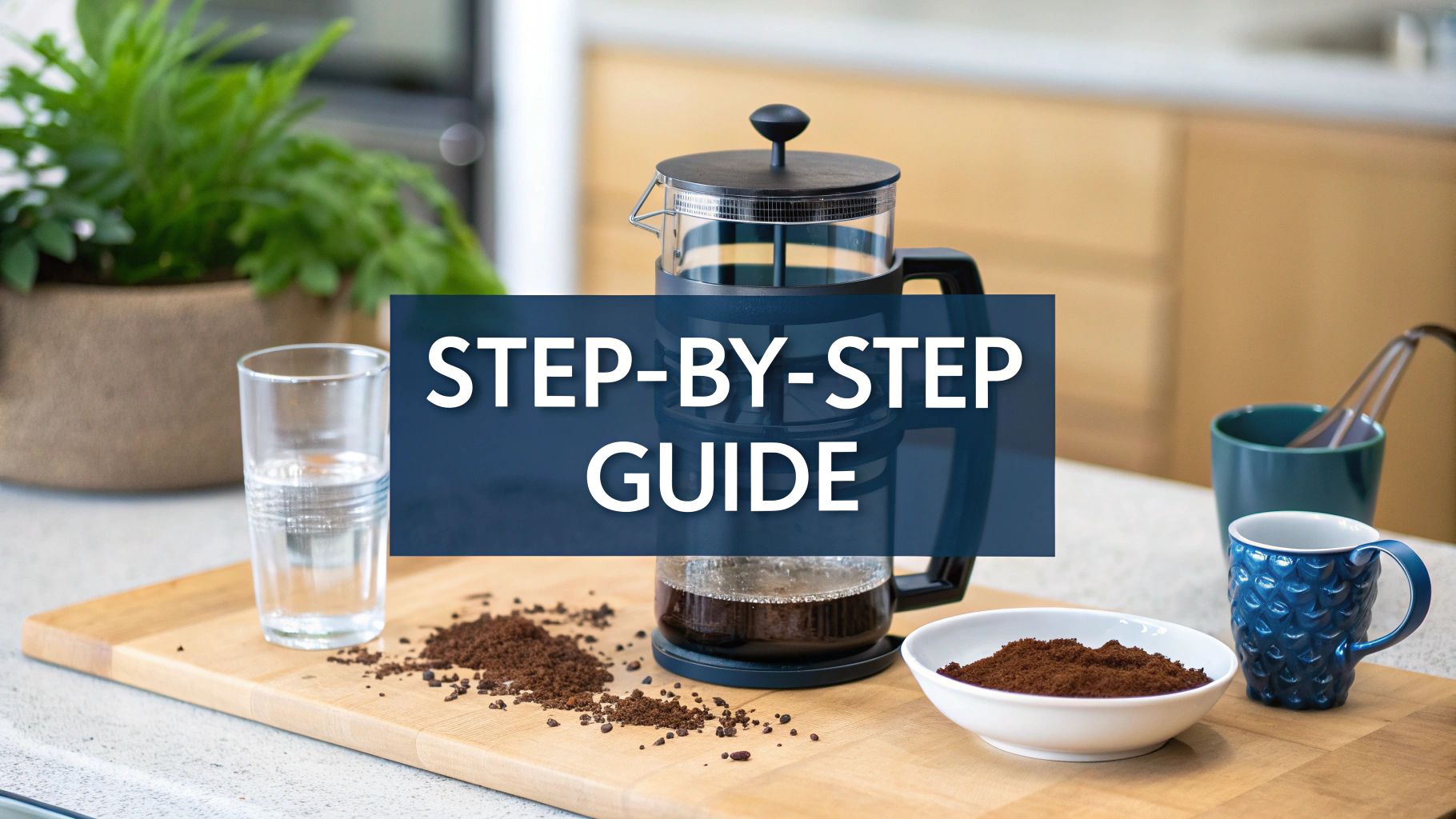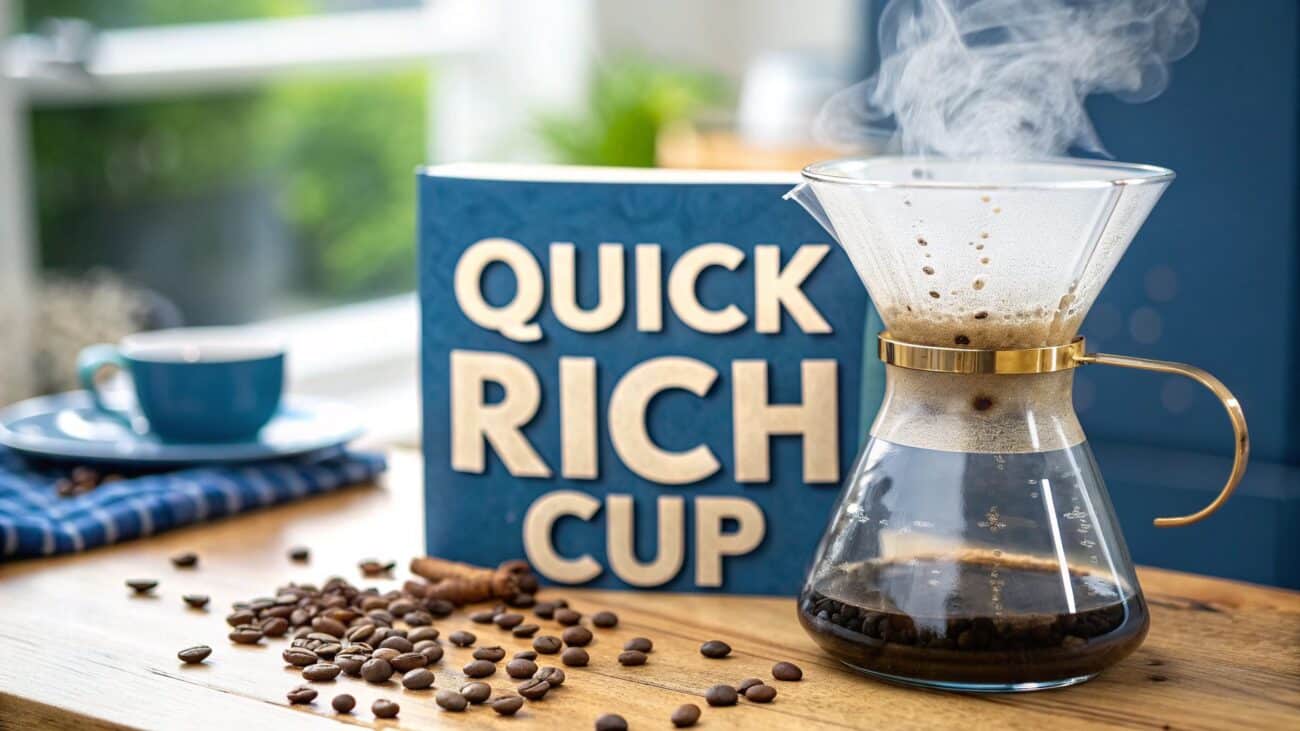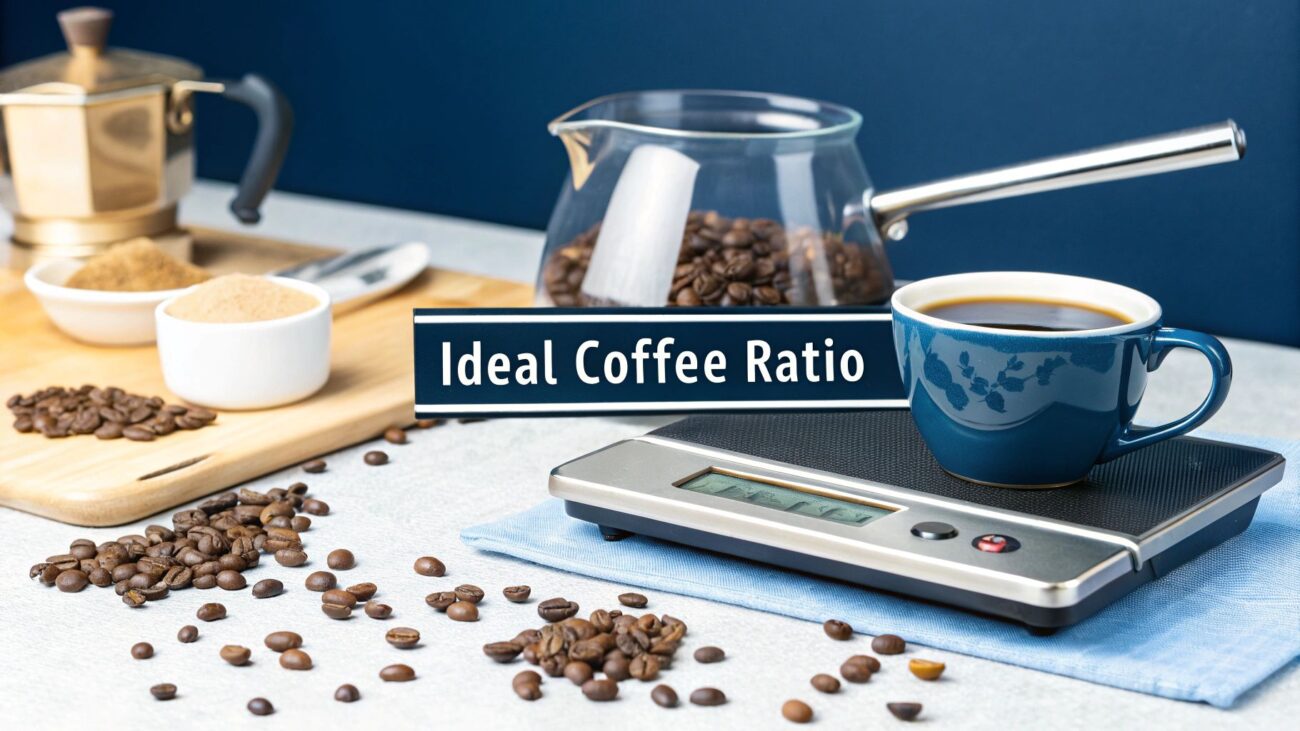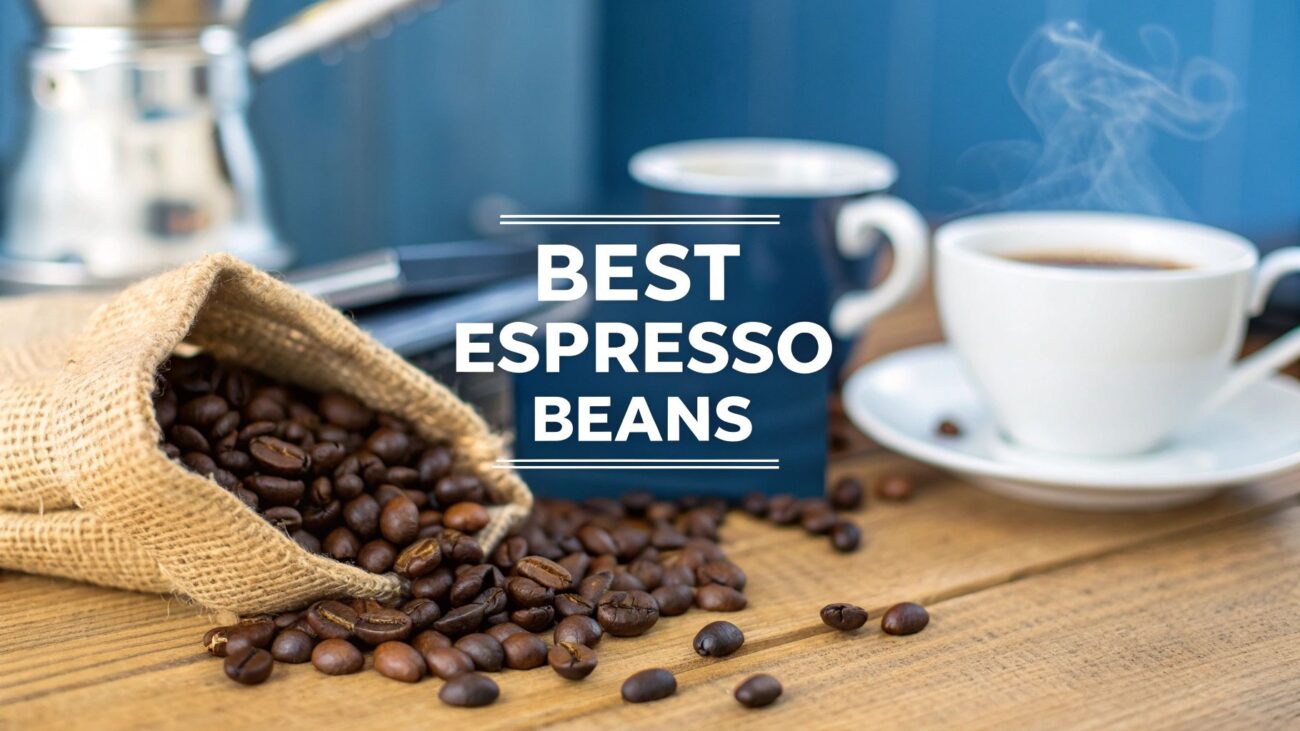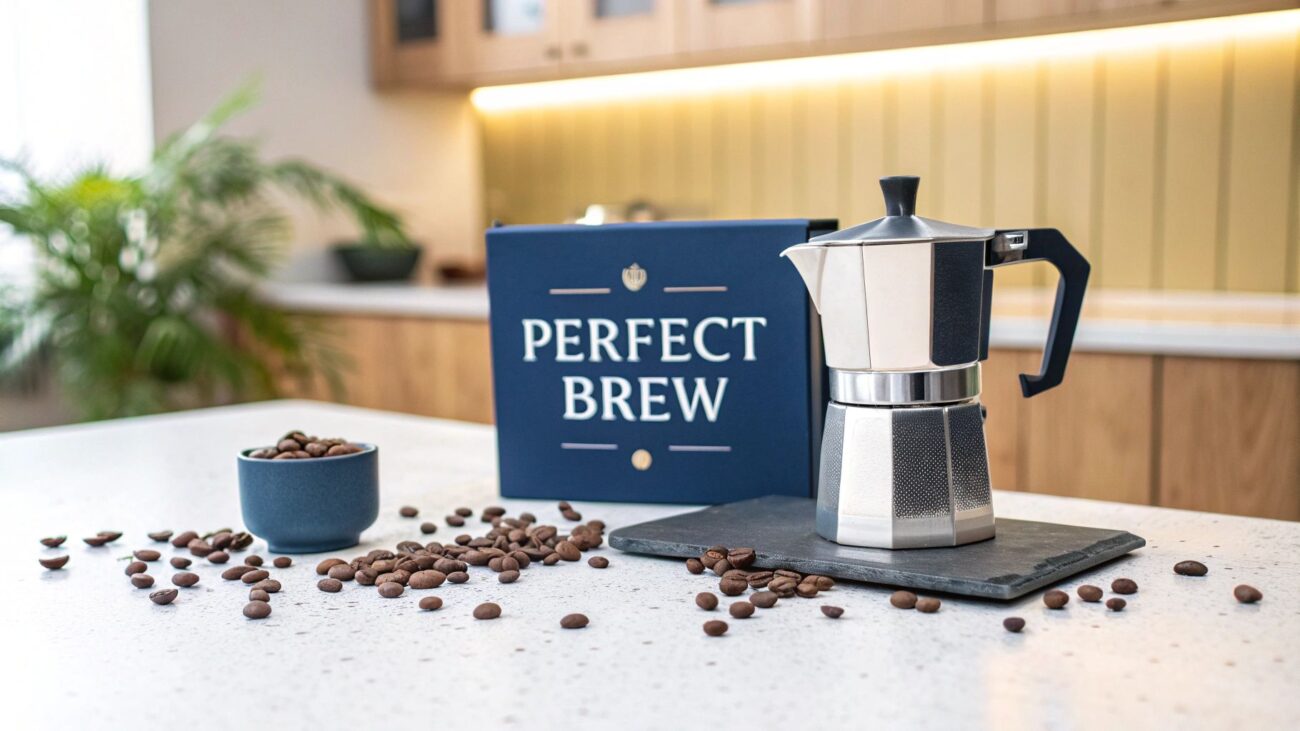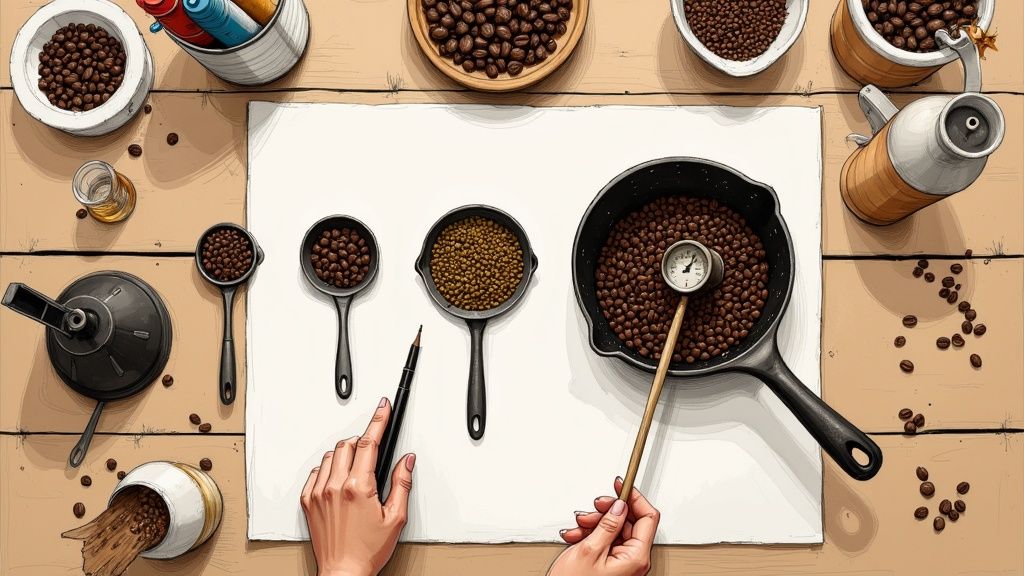The Best Coffee for Cold Brew: A UK Guide
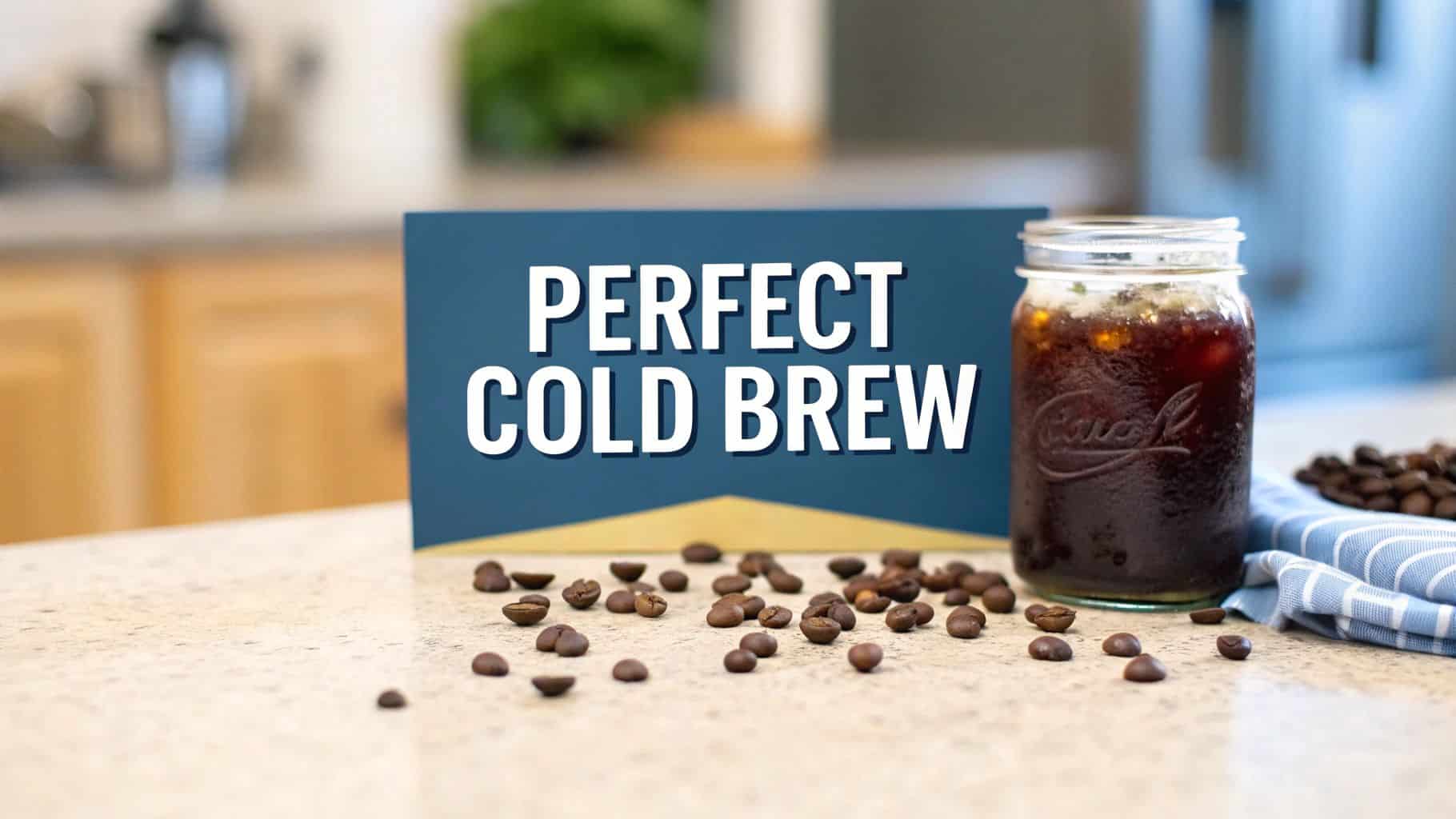
For the smoothest, richest cold brew imaginable, you'll want to start with a medium to dark roast that has a naturally low acidity. Beans from places like Brazil or Colombia are fantastic choices; their inherent chocolatey and nutty flavours are a perfect match for the slow, gentle extraction that makes cold brew so special. Above all, a coarse grind is non-negotiable—it's the key to avoiding a bitter, cloudy mess.
Your Guide to Perfect Cold Brew Coffee at Home
Welcome to the definitive guide on choosing the right coffee for your cold brew. If you've ever made a batch at home only to find it tasted bitter or disappointingly weak, the beans are almost always the culprit. This guide is designed to pull back the curtain on the whole process, turning you from a curious beginner into a home brewer who gets it right every time.
We’re going to explore why some coffees produce that sublimely smooth, rich concentrate while others just fall completely flat. Think of it like cooking: you wouldn't flash-fry a cut of meat that's meant for a slow roast. Cold brewing is the same; its slow, patient nature brings out every single nuance of the bean, for better or worse.
Why Your Bean Choice Matters
This brewing method is more than just a trend; it's exploding in popularity. In fact, the United Kingdom’s cold brew coffee market is projected to grow at a compound annual growth rate of 20.6% between 2025 and 2034. This isn't just a niche market—it reflects a massive shift in how people enjoy coffee, especially in cities. With over 52 million people living in UK urban centres as of 2023, the demand for convenient, quality on-the-go drinks is soaring. You can dive deeper into the UK cold brew market trends to see just how quickly it's catching on.
All this interest means more and more people are trying to nail their technique at home. Success really comes down to understanding a few core principles. A truly great cold brew hinges on three key elements:
- The Roast Profile: How dark the beans are roasted dramatically changes their flavour and acidity.
- Bean Origin: Where the coffee is grown gives it unique tasting notes, from fruity to earthy.
- Grind Size: This is the one you absolutely cannot compromise on. The wrong grind can ruin even the best beans.
The secret to phenomenal cold brew isn’t some complicated machine or a secret ingredient. It’s simply about choosing the right coffee beans and giving them the patience this slow-infusion method deserves.
Once you get a handle on these fundamentals, you'll understand both the science and the art behind a perfect brew. We'll cover everything from the ideal roast level and bean origin to why grind size is so critical. By the end, you'll know exactly how to pick beans that deliver a naturally sweet, low-acidity coffee every single time.
Why Your Choice of Coffee Bean is Everything for Cold Brew
To really get why some beans make incredible cold brew and others fall flat, we have to look at how different it is from your typical hot brew. Hot brewing is a flash in the pan—it’s fast and aggressive. The near-boiling water rips out oils, compounds, and acids in a hurry, which can sometimes bulldoze over a bean’s subtler notes or even mask its flaws.
Cold brewing is the complete opposite. It’s a slow, gentle dance. Over 12 to 24 hours, the cool water patiently coaxes the flavour out of the grounds. This unhurried steep puts the bean’s inherent qualities under a microscope, making your initial choice absolutely critical for a great result.
Using a poor-quality bean for cold brew is like making a slow-cooked stew with mediocre ingredients; there’s simply nowhere for flaws to hide. The final drink will taste muddy, bland, or just plain uninspired. But the right bean? That’s where the magic happens, giving you a brew that’s impossibly smooth, rich, and humming with complex character.
What’s Happening in the Water?
The secret to cold brew’s unique charm lies in its extraction chemistry. Hot water is brilliant at dissolving all the good stuff in coffee, but it also pulls out a lot of acidic compounds and tannins. These are the culprits behind the sharp, bitter notes you sometimes get in a hot cup.
Cold water is much more selective. It dramatically reduces how many of these bitter-tasting acids it extracts, which is why the final brew is so much smoother and easier on the palate.
This gentle method is precisely why we love cold brew for its low acidity and velvety texture. It lets the coffee’s natural sweetness and delicate flavours—think chocolate, nuts, and caramel—step into the spotlight without being drowned out by bitterness. So, starting with the right beans isn't just a suggestion; it’s non-negotiable.
The UK's Growing Thirst for Smoothness
That distinctively smooth profile has really caught on with coffee drinkers across the country. It’s a massive shift, especially when you remember the category barely existed a decade ago. Now, up to 43% of UK coffee consumers drink cold brew at least once a month, according to a 2025 consumer survey. It’s particularly popular with younger drinkers who are drawn to that smoother, less acidic taste—a direct result of that gentle, 12-24 hour steeping process. This boom in popularity makes understanding bean selection more important than ever. If you want to dive deeper into what's driving this trend, you can read the full research on commercial cold brew trends at Hardtank.com.
The quality of your brew is decided long before water ever meets the grounds. It starts with the bean.
By choosing beans with a flavour profile that complements the cold brew method, you are setting the stage for a rich, complex, and incredibly smooth cup of coffee. It’s the difference between a good cold brew and a truly exceptional one.
Choosing the right bean isn’t just about avoiding a bad taste; it’s about unlocking a fantastic one. Whether you go for a masterfully created blend or want to discover the world of single-origin coffee, the core principles are the same. The origin, roast, and freshness all play a vital role. Ultimately, the bean is the foundation upon which your entire cold brew experience is built.
Choosing the Right Roast Profile for Your Brew
When it comes to cold brew, the roast level of your coffee isn't just a minor detail—it’s arguably the single most important factor shaping the final taste in your glass. Hot brewing is a fast and furious process, using high temperatures to yank flavours out of the grounds. Cold brew is the complete opposite. It’s a slow, gentle steep, and this fundamental difference means various roasts perform in wildly different ways.
Getting your head around this is the key to making a cold brew you’ll genuinely love.
Think of it like toasting bread. A light toast is still quite grainy and bright, keeping much of the original wheat character. Take it darker, and you start developing those deep, caramelised, and rich flavours. Coffee beans go through a similar transformation in the roaster, and for cold brew, that transformation is everything.
The long, cool steeping process is brilliant at pulling out deep, smooth flavours but struggles to extract the delicate, bright, and acidic notes common in lighter roasts. If you try to make cold brew with a light roast, you’ll likely end up with something disappointingly thin, grassy, or even unpleasantly sour.
Why Darker Roasts Excel in Cold Brew
This is where medium and dark roasts step into the spotlight. As the beans tumble in the roaster for longer, they undergo the Maillard reaction and caramelisation. These are the same chemical reactions that give a steak its sear and onions their sweetness. In coffee, they break down complex sugars and sharp acids, creating rich, deep flavours that are absolutely perfect for a slow, cold extraction.
What you get is a brew bursting with notes of chocolate, caramel, nuts, and toffee. These flavour compounds are much more soluble in cold water. This means the gentle steeping method can pull them out completely, resulting in that classic smooth, sweet, and full-bodied cold brew profile everyone’s after.
The infographic below gives you a great visual on how the beans change. You can see the colour deepen, which is a direct signal of how the flavour is developing.
As the beans go from light to dark, you're watching acidity drop and the body and inherent sweetness ramp up.
A Deeper Look at Each Roast Level
To really nail your brew, it helps to know exactly what each roast level brings to the party. While taste is always personal, the science of extraction definitely picks a favourite when it comes to cold brewing.
The entire goal of cold brewing is to minimise acidity and maximise that smooth, rich body. Medium to dark roasts are chemically built to deliver this, while light roasts are structured to fight against it.
Let's break down how each profile typically behaves:
- Light Roasts: These beans are all about preserving their origin characteristics. They’re high in acidity with bright, often floral or citrusy notes. In a cold brew, these beautiful, delicate flavours just don't show up properly, and the acidity often comes across as sour.
- Medium Roasts: For many, this is the cold brew sweet spot. A medium roast strikes a fantastic balance, dialling back the sharp acidity of a light roast while developing those lovely chocolatey and nutty flavours. It makes for a smooth, well-rounded brew with a satisfying body and natural sweetness.
- Dark Roasts: If you love a cold brew that’s bold, rich, and intense, this is your go-to. Dark-roasted beans are very low in acidity and packed with deep, smoky, and dark chocolate notes from their extended time in the roaster. They produce a heavy-bodied concentrate that’s practically begging for a splash of milk and a handful of ice.
Cold Brew Roast Profile Comparison
To make it even clearer, here’s a straightforward comparison of how each roast profile typically performs when used for cold brew.
| Roast Profile | Typical Flavour Notes | Acidity Level | Body | Recommended for Cold Brew? |
|---|---|---|---|---|
| Light Roast | Bright citrus, floral, grassy, fruity | High | Thin, tea-like | Not ideal. Flavours struggle to extract, often resulting in a sour or weak brew. |
| Medium Roast | Chocolate, caramel, nuts, brown sugar | Medium to Low | Smooth, well-rounded | Excellent choice. Creates a balanced, sweet, and classic cold brew profile. |
| Dark Roast | Dark chocolate, smoky, roasty, earthy | Very Low | Heavy, syrupy | Highly recommended. Perfect for a bold, intense concentrate that holds up well with milk. |
While you can technically make cold brew with any coffee, this table shows why medium and dark roasts are the most reliable path to a delicious and satisfying result.
If you're curious to dive deeper into how the roasting process shapes flavour, our guide explaining coffee roasting profiles is a great next step.
Ultimately, the best coffee is the one you enjoy most, so don't be afraid to experiment. But if you want to guarantee a great-tasting, classic cold brew right from the start, grabbing a bag of medium or dark roasted beans is your safest bet.
Finding the Best Bean Origins for Cold Brew
Just as the unique soil and climate of a vineyard give a wine its distinct character, a coffee bean's origin country shapes its entire flavour profile. For cold brew, where nuances are gently coaxed out over many hours, choosing beans from the right region is a game-changer. It’s the difference between a good cup and a truly memorable one.
While a dark roast is your starting point, the bean's origin story adds the next layer of flavour. Some regions are famous for producing beans with the exact characteristics that thrive in a cold brew environment: low acidity, full body, and rich, deep notes.
South and Central America: The Classics
When you think of classic coffee flavours—smooth, chocolatey, and nutty—you're likely picturing beans from South and Central America. These regions are powerhouses in the coffee world, and their beans are exceptionally well-suited to the cold brew method. They provide a reliable and delicious foundation for your brew.
-
Brazil: Brazilian coffees are the undisputed champions of low acidity. They are known for their mellow, sweet, and nutty profiles, often with prominent notes of milk chocolate and roasted almond. This makes them a perfect, crowd-pleasing choice for a smooth, balanced cold brew.
-
Colombia: A close second, Colombian beans offer a slightly more complex profile. They deliver a wonderful balance of caramel sweetness and nutty undertones, but with a richer, more full-bodied mouthfeel. If you want a classic cold brew with a bit more depth, Colombia is an excellent option.
Asia: Bold and Earthy Flavours
Moving across the globe, Asian coffees bring an entirely different character to the table. They are often bold, intense, and wonderfully complex, making for a cold brew that is anything but boring.
For a truly decadent and full-bodied cold brew, Sumatran beans are hard to beat. Their earthy, almost syrupy character creates a concentrate with incredible depth and richness, standing up beautifully to milk or cream.
The most famous origin in this region for this style is Sumatra. Sumatran coffees are renowned for their heavy body and deep, earthy flavours. You'll often find notes of dark chocolate, cedar, and even a hint of spice. This low-acid profile makes them an outstanding candidate for an intense and memorable cold brew concentrate.
Why You Might Avoid Some African Beans
African coffees, particularly those from Ethiopia or Kenya, are often celebrated in the world of hot coffee for their bright, vibrant acidity and delicate floral or fruity notes. They are grown at high altitudes, which produces dense beans packed with these complex acids.
However, these are the very qualities that often make them less than ideal for a traditional cold brew. The gentle cold water extraction process struggles to properly pull out their delicate, bright flavours, while the high acidity can translate into a sour or thin-tasting final product.
While some experimental brewers enjoy the challenge, if your goal is a classic smooth and rich cold brew, it's generally best to stick with lower-altitude, lower-acidity beans from regions like Brazil or Sumatra.
Exploring different origins allows you to customise your brew to your exact taste. By looking beyond generic blends and selecting single-origin coffees, you can take control of the final flavour profile. Whether you prefer the comforting chocolate notes of a Brazilian bean or the bold earthiness of a Sumatran, understanding origin is a key step towards perfection. You can explore a wide variety of specialty coffee beans from around the world to start your own flavour journey.
The Critical Role of Grind Size and Freshness
You can have the most perfect, ethically sourced medium-roast beans from Brazil, but if your grind is off, all that beautiful potential flavour goes straight down the drain. After the roast, grind size is without a doubt the most important part of making a truly delicious cold brew. It’s the gatekeeper that controls how water and coffee interact, defining the entire extraction process from start to finish.
Think of it like making a pot of tea. If you tip a load of fine tea powder into the water, you’ll get a cloudy, bitter mess that’s a nightmare to strain. Use whole leaves, however, and the water flows freely, gently coaxing out the flavour for a clean, aromatic drink. Making cold brew works on the exact same principle.
Why a Coarse Grind is Non-Negotiable
For cold brew, a coarse grind isn't just a suggestion—it's essential. You want your ground coffee to look and feel like coarse sea salt or breadcrumbs. This larger particle size is make-or-break for a couple of key reasons.
First, it’s all about even water saturation. During that long, slow 12-24 hour steep, the water needs to get to every single coffee ground without any trouble. A coarse grind creates plenty of space for water to circulate, preventing dry clumps from forming and ensuring you get a balanced, consistent extraction.
Second, it’s your best defence against over-extraction, which is the number one cause of bitterness in coffee. Finer grounds have a huge amount of surface area, so they release all their soluble compounds way too fast during a long steep. The result? A harsh, bitter brew. A coarse grind slows that whole process right down, gently drawing out only the sweet, smooth flavours we’re after.
If you try to use a fine grind, you'll end up with a muddy sludge that not only tastes awful but is also nearly impossible to filter properly. No one wants a gritty, unpleasant coffee. If you’re not sure what different grinds should look like, this handy coffee grind size guide has some great visual examples.
Freshness is Flavour
Alongside getting the grind right, freshness is everything. The second you grind coffee, it starts a race against time. Precious aromatic compounds and oils begin to oxidise and disappear. These volatile compounds are exactly what give a great cup of coffee its incredible depth and complexity.
Pre-ground coffee might be convenient, but it has already lost a huge chunk of its flavour potential before it even gets to your kitchen. Grinding whole beans just moments before you start steeping is the single biggest upgrade you can make to your home cold brew. It’s what separates a good coffee from an exceptional one.
Grinding your beans fresh is like using fresh herbs instead of dried ones in your cooking. The difference in aroma and flavour is immediate and undeniable, bringing a vibrancy to your brew that pre-ground coffee simply cannot match.
For the best results at home, a burr grinder is your best friend. Blade grinders just smash and chop beans unevenly, but a burr grinder crushes them between two revolving surfaces. This creates a much more uniform coarse grind, which is the key to a clean, balanced, and delicious extraction.
Finally, don't let good beans go bad. To keep them at their peak, you need to protect them from their four main enemies: oxygen, light, heat, and moisture. Just follow these simple tips:
- Store them whole: Only grind what you need, right before you brew.
- Use an airtight container: An opaque, airtight canister is perfect for the job.
- Keep it cool and dark: Store your container in a pantry or cupboard, well away from the oven or any other heat sources.
By mastering the coarse grind and committing to freshness, you're making sure all those wonderful qualities from your carefully chosen beans actually make it into your cup.
Your Step-by-Step Cold Brewing Method
Alright, you’ve picked your beans and understand what makes a great roast, origin, and grind work for cold brew. Now it's time for the fun part: putting it all together. This is our practical, no-fuss guide to making a perfect batch at home, turning those carefully chosen beans into an incredibly smooth, rich, and refreshing drink.
One of the first hurdles for newcomers is getting the coffee-to-water ratio right. It’s the key to hitting that perfect strength and flavour. A great starting point for a brew you can drink straight away is a 1:8 ratio by weight. Think 1 gram of coffee for every 8 grams of water.
If you’d rather make a strong concentrate that you can dilute later with water or milk, a 1:4 ratio is your best bet. This creates a potent brew that gives you more control over the final drink and keeps well in the fridge.
The Brewing Process Step by Step
Making fantastic cold brew is less about skill and more about patience. The process itself is wonderfully simple and you likely already have everything you need, like a large jar or a French press.
-
Grind Your Beans: Start with your fresh, whole beans. You’ll want a coarse consistency, something like rough sea salt. This is probably the most important step for preventing a bitter, cloudy brew.
-
Combine Coffee and Water: Tip your coarsely ground coffee into whatever you’re brewing in (a big Mason jar is perfect). Pour your cold, filtered water over the grounds, making sure every last one is soaked.
-
Give it a Gentle Stir: Grab a long spoon and give the mixture a gentle stir. You’re just looking to break up any dry clumps of coffee, which ensures a nice, even extraction.
-
Steep Patiently: Cover your container and just let it sit at room temperature for anywhere between 12 to 24 hours. The right amount of time really comes down to personal taste. A shorter steep gives a milder coffee, while a longer one creates a much stronger, more intense flavour. We’ve found 18 hours is the sweet spot for most beans.
The real magic of cold brew happens during this long, slow steep. It’s a patient infusion where the water gently coaxes out all the sweet, chocolatey notes from the coffee while leaving the harsh, bitter acids behind.
Filtering for a Clean Finish
Once your coffee has finished its long steep, the final step is to separate the liquid from the grounds. The goal is a clean, sediment-free brew, and there are a couple of easy ways to get there.
Using a French Press:
If you used a French press to steep, you're in luck—this is the easiest method by far. Just press the plunger down slowly and carefully. Pour your finished cold brew into another container for storage, and you’re done.
Using a Jar and Strainer:
For those who went with a jar, you'll need a fine-mesh sieve and either some cheesecloth or a standard paper coffee filter.
- Place the sieve over a large bowl or pitcher.
- Line the sieve with a double layer of cheesecloth or a single paper filter.
- Slowly pour the entire cold brew mixture through the lined sieve.
This double-filtration method is fantastic for catching even the tiniest particles, leaving you with a super-smooth texture. Once it's all filtered, transfer your cold brew to an airtight bottle or jar. It will happily keep in the fridge for up to two weeks.
For more detailed instructions and a few extra tips, have a look at our complete guide on how to make cold brew coffee.
Still Got Questions About Cold Brew?
Even with the perfect beans in your basket, a few questions might still be bubbling up. Let’s tackle some of the most common queries to make sure you can brew with absolute confidence.
Can I Use Pre-Ground Coffee for My Cold Brew?
You technically can, but if you’re chasing the best possible flavour, it's not the way to go. The moment coffee is ground, it starts losing its precious aromatic oils and all those delicate flavour compounds. That means a brew made from pre-ground coffee will always taste a bit flatter, lacking the vibrancy you get from fresh beans.
For a truly rich and complex taste, always buy whole beans and grind them coarsely right before you steep them. If you absolutely must use pre-ground, look for a bag labelled 'coarse' or 'French press' grind, and use it as fast as you can after cracking the seal.
What Is the Difference Between Cold Brew and Iced Coffee?
The real difference is all in the brewing. Iced coffee is just regular hot-brewed coffee that's been cooled down, usually by pouring it over a mountain of ice. This method tends to lock in the higher levels of acidity and bitterness that come with hot water extraction.
Cold brew is a completely different beast. It never sees any heat. Instead, it’s made by steeping coffee grounds in cold water for a long, slow 12-24 hours. This gentle, patient process creates a concentrate that's remarkably smooth, far less acidic, and has a naturally sweet flavour profile.
How Long Does Cold Brew Concentrate Last?
Once your batch is ready, the good news is that your concentrate will stay fresh for a good while if you store it properly. Keep it in a sealed, airtight container in the fridge, and it can last for up to two weeks.
That said, its flavour is at its absolute peak within the first week. After seven days or so, you might start to notice the more delicate notes fading away, and it can begin to taste a little stale. For the best experience, we recommend making a batch you can comfortably drink within 7-10 days. That way, every glass tastes as fresh and delicious as the first.
Ready to start your cold brew journey? Explore our exceptional single-origin beans and expertly crafted blends at Seven Sisters Coffee Co and discover your perfect match. Find your next favourite coffee at https://sevensisterscoffee.co.uk.

